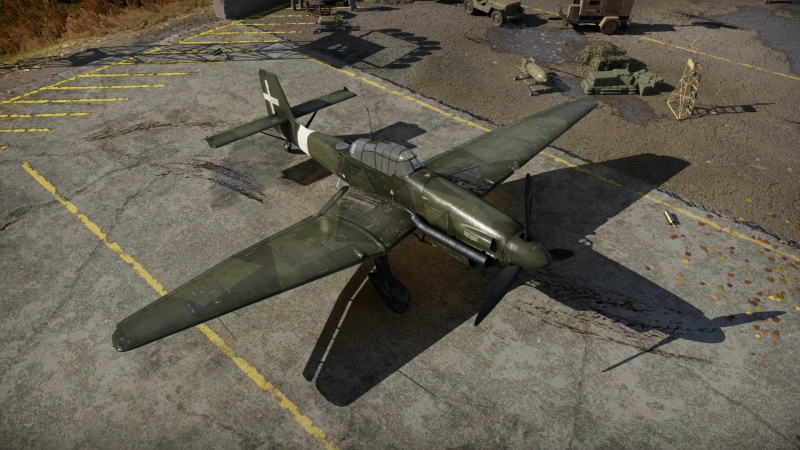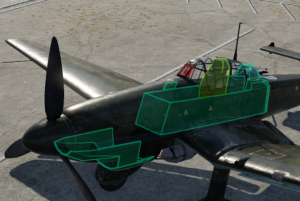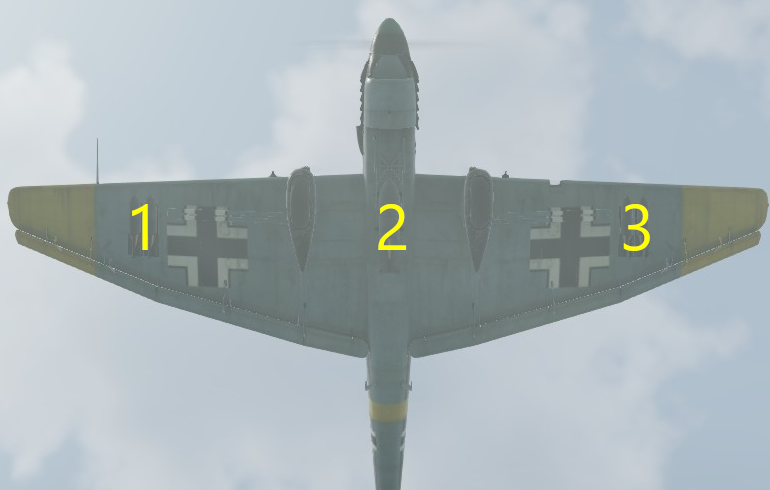Ju 87 D-3 (Italy)
| This page is about the dive bomber Ju 87 D-3 (Italy). For the German version, see Ju 87 D-3. For other versions, see Ju 87 (Family). |
Contents
Description
The ▄Ju 87 D-3 is a rank Italian dive bomber with a battle rating of (AB), (RB), and (SB). It was introduced in Update 1.85 "Supersonic".
The Ju 87 D-3 (Italy) is a slow bomber when flying but decently fast in a dive. It is fairly durable for its battle rating, being able to take a decent amount of 7.7 mm and 12.7 mm fire before being fully disabled, but this doesn't mean you should fly in a straight line. The Stuka has a very low stall speed and is very manoeuvrable at lower speeds giving it an edge in a dive bomb run or a turn fight. The offensive and defensive armaments are a bit underwhelming, but can still heavily damage enemy aircraft in close proximity. In a dive attack, deploy the air brakes to control the acceleration so you don't gain too much speed and slam into the ground.
Its armament consists of two MG 17s mounted in the wings, very good for killing soft ground targets like armoured cars and AA, and has a good bomb load for destroying hard targets like tanks, pillboxes, ships and bases. Its defensive turret consists of two fast-firing MG 81s but they are not lethal enough to shoot down planes reliably.
General info
Flight performance
| Characteristics | Max Speed (km/h at 4,000 m) |
Max altitude (metres) |
Turn time (seconds) |
Rate of climb (metres/second) |
Take-off run (metres) | |||
|---|---|---|---|---|---|---|---|---|
| AB | RB | AB | RB | AB | RB | |||
| Stock | 369 | 359 | 32.4 | 33.9 | 8.7 | 8.7 | 513 | |
| Upgraded | 402 | 385 | 29.7 | 31.0 | 14.3 | 11.2 | ||
Details
| Features | ||||
|---|---|---|---|---|
| Combat flaps | Take-off flaps | Landing flaps | Air brakes | Arrestor gear |
| X | ✓ | ✓ | ✓ | X |
| Limits | ||||||
|---|---|---|---|---|---|---|
| Wings (km/h) | Gear (km/h) | Flaps (km/h) | Max Static G | |||
| Combat | Take-off | Landing | + | - | ||
| N/A | 454 | 320 | ~13 | ~5 | ||
| Optimal velocities (km/h) | |||
|---|---|---|---|
| Ailerons | Rudder | Elevators | Radiator |
| < 270 | < 270 | < 350 | > 325 |
| Compressor (RB/SB) | ||
|---|---|---|
| Setting 1 | ||
| Optimal altitude | 100% Engine power | WEP Engine power |
| 4,000 m | 1,180 hp | 1,390 hp |
Survivability and armour
- 4 mm steel underneath engine
- 4 mm steel tub surrounding pilot and gunner
- 4 mm steel around gunner turret
- 4 mm steel in front of gunner
- 8 mm steel pilot's seat
- 8 mm steel pilot's headrest
- 50 mm (51°) bulletproof glass in front of pilot
- 4 self-sealing fuel tanks, 2 in each wing (wing root and mid-wing)
This protects the pilot and gunner from most shrapnel pieces and gives the engine some extra protection from small calibre gunfire from below.
Modifications and economy
Armaments
Offensive armament
The Ju 87 D-3 (Italy) is armed with:
- 2 x 7.92 mm MG 17 machine guns, wing-mounted (1,000 rpg = 2,000 total)
With 2 MG 17 installed at the wing roots, the gunner can destroy soft ground targets (artillery position, AA vehicle or armoured car) or damage overshooting enemy aircraft. However, you can't inflict heavy damage to other aircraft as your calibre is too small but you can cripple them badly enough to abort mission and return to base. Engage below 500 m distance to make sure you reliably damage the targets you're going after. For information on the available belts, visit the MG page (link above).
Suspended armament
The Ju 87 D-3 (Italy) can be outfitted with the following ordnance:
| 1 | 2 | 3 | ||
|---|---|---|---|---|
| 50 kg GP 50 bombs | 2 | 2 | ||
| 100 kg GP 100T bombs | 2 | 2 | ||
| 250 kg GP 250 bombs | 1 | |||
| 500 kg GP 500 bombs | 1 |
| Default weapon presets | |
|---|---|
| |
Defensive armament
The Ju 87 D-3 (Italy) is defended by:
- 2 x 7.92 mm MG 81 machine guns, dorsal turret (1,000 rpg = 2,000 total)
With a traverse angle of ±60° and an elevation angle of -15°/+70°, the rear gunner can effectively cover the Ju 87 D-3 (Italy) from opponents attacking from behind. The fast-firing MG 81 machine guns are quickly depleted and they overheat after a few seconds of continuous fire so use them sparsely (burst-firing). The tail of the Junkers is massive and will provide cover for enemy aircraft when they're directly behind you, change your heading by a few degrees to prevent that. Unlike the TBF-1c or the B6N bombers, your gunner can't reach pursuing aircraft flying well under your plane's level. Fly close to the ground to avoid this situation. For information on the available belts, visit the MG page (link above).
Usage in battles
- Air Arcade Battles
In Arcade Battles, you should concentrate on destroying ground targets: use your bombs for tanks and pillboxes first and use your offensive machine guns for soft targets like armoured cars, artillery, howitzers and AA. In this mode, you won't need your air brakes since you can't break your wings and it's easy to pull up from a high-speed dive. It's also recommended that you maintain a high speed after dive-bombing so you can escape unscathed and keep a distance between your plane and pursuing enemy aircraft.
Because of its low speed, non-retractable landing gear and reasonable durability, the Ju 87 D-3 (Italy) is quite good for capturing airfields in the Arcade "Domination" mode.
- Air Realistic Battles
In Realistic Battles, you should keep your altitude, and look for tank columns to attack (ground targets as far from the battlefield or enemy airfield as possible are recommended, so that you are less likely to be intercepted). Once you are right over your intended target, set your throttle to 0% and point your nose at the tank you want to destroy (since you have no bombsight, there will not be a bomb-drop indicator like in Arcade, and you will have to guess where the bombs will land). Once you are nearing your target, you will have to deploy your air-brakes or you won't be able to pull up at high speeds. You can tell when you are reaching a high speed with the sounds that the air and wings make. Once you drop your bomb(s) point your nose up to pull up. At this point, you can use your offensive armament to destroy soft targets like AA, engage enemy fighters that are nearby (which is very likely), or head back to the airfield to rearm for another run.
Dogfighting in RB with the Ju 87 is a very difficult task if the enemy knows your advantages and disadvantages and uses them to his advantage. Head-on attacks are very much not recommended, as the Ju 87's relatively weak armament severely lowers its chances of succeeding or surviving. Instead, stay low and slow in a combat situation with enemy aircraft (because of the Ju 87's control stiffening at high speeds) and try to trick the enemy into a turn fight. If he falls for your turn fight, you should end up on his 6 o'clock in 3-5 turns on most enemies, depending on the turn rate of the enemy plane. If he doesn't fall for your turn fight, you are most likely going to go down... this plane is not a fighter plane.
When returning to base, landing and takeoff is simple, and use of the air brakes will help if you come in too fast to land.
- Tank Realistic Battles
Take a modular payload of 5 bombs of 1 x 250 or 500 kg plus 4 x 100 kg into battle, forget about 50 kg bombs whose effect is too weak to secure the destruction of an enemy tank. Bombs loaded on the wings drop together by pair, the last one is under the fuselage, meaning that with accurate aiming, you can consistently destroy two to three enemy ground vehicles. It is recommended to set up a fuse of at least 1.5 seconds to have time to clear the blast zone. Do not use the 100 kg bombs against heavy tanks.
Your goal is to evolve at an altitude between 1,500 and 2,000 m above the battlefield. Once you've identified a target, fly towards its position while keeping your altitude. Proceed then to dive and reach a speed of 450 km/h, extend the airbrake to control the acceleration (and set the throttle on zero if needed) so that you stay at that speed. Zoom in on the target and when it is twice as big as the mouse cursor, place the target between the cursor and the cockpit, and release the bomb. Trajectories vary depending on the weight of the bomb: place the target closer to the cursor for the 100 kg bomb and for the 500 kg one, closer to the cockpit. You can shoot a burst with your offensive machine guns to estimate your attack angle. Release your bombs around 1,000 m and pull on the stick to fly away and regain altitude. Once all bombs are out, return to your airfield to rearm for another run or target lightly armoured vehicles with your machine guns (SPAA, armoured car, light tank, open-topped SPG, etc.). If you are attacked by an enemy plane from behind, use your defensive MG and put a stray of 7.92 mm bullets into it, but use the Armoured Targets belt to compensate for the small calibre.
- Enemies worth noting
- Hurricane Mk IV · Ki-44-II otsu - With two 40 mm cannons, these fighters will cut the Ju 87 D-3 (Italy) in half.
- He 112 B-0 · He 112 B-1/U2 · He 112 B-2/U2 · Bf 109 E-3 · MiG-3-34 · IL-2 (1941) · Yak-2 KABB · I-29 · IAR-81C - With two 20 mm cannons, any of these aircraft can damage vital parts like the engine or cooling systems.
- LaGG-3-8 · LaGG-3-35 · Yak-1 · Yak-9B · M.S.406C1 · M.S.410 · V.G.33C-1 - With a single 20 mm cannon supported by machine guns, these planes are also dangerous for the Stuka to a lesser extent.
- P-40 (Family) · A-36 · F4U-1A · ▄Corsair F Mk II · A-20G-25 · Ki-61-I otsu · ␗Ki-61-I otsu · ␗Ki-44-II hei - With four to six 0.50 cal machine guns, these aircraft can inflict heavy damage to your airframe.
- Hurricane Mk I/L · Hurricane Mk.I/L FAA M · Hurricane Mk IIB/Trop · Sea Hurricane Mk IB · Spitfire Mk Ia · Spitfire Mk IIa · Typhoon Mk Ia - With eight to twelve 0.303 machine guns, these fighters can turnfight the Junkers and thus can damage you if you stay exposed for too long to their saturating fire. Avoid dogfighting these planes in general.
Manual Engine Control
| MEC elements | ||||||
|---|---|---|---|---|---|---|
| Mixer | Pitch | Radiator | Supercharger | Turbocharger | ||
| Oil | Water | Type | ||||
| Not controllable | Controllable Not auto controlled |
Not controllable Not auto controlled |
Controllable Not auto controlled |
Separate | Not controllable 1 gear |
Not controllable |
Pros and cons
Pros:
- Easy landing and takeoff
- Good low-speed manoeuvrability
- Precision bombing accuracy, has air brakes
- Good ammunition amount for the 7.92 mm machine guns
- Fast-firing defensive armament
- Can perform both level and dive bombing equally
- Well armoured
- Lower profile cockpit and no more large radiator below the engine
Cons:
- Very slow aircraft
- Poor climb rate
- No bomb-sight, but with enough flight hours, precision bombing can be easily mastered
- Defensive armament is inadequate against well armoured and well-coordinated foes
- Poor stock performance
- No suspended guns, unlike the D-5 model
History
Procurement
In early 1939, a commission of the Luftwaffe met the Regia Aeronautica in Italy to share technology and knowledge. The Luftwaffe tested Italian aircraft and the Italian Air Force tested the Junkers 87. The dive bombing technique was not commonly used by Italian bombers as they lacked capable planes like the Stuka. The Italian government ordered 100 Ju 87 B-2 following the visit of the Luftwaffe. Italian fighter pilots were sent in Austria to be trained as Stuka pilots and in the summer of 1940, the Regia Aeronautica had its first dive bombing group followed later by additional squadrons.
The first 50 planes were Ju 87 B-2 while the 50 following were Ju 87 R-2, a version derived from the B-2 focused on the anti-ship role and with greater autonomy thanks to drop fuel tanks. They were later upgraded to the R-5 version. The initial Italian Stukas were mainly used against Malta and the allied ships convoys in the Mediterranean and in North Africa, where they took part in the siege of Tobruk in 1941. As the war continued in Europe, the Italian Air Force received additional Ju 87 B-2 and R-5 for a total of 159 aircraft in 1942. The Regia Aeronautica received the D-3 version in 1943. The D-3 variant was derived from the D-1 (which had a better engine and better armament than previous versions) and was specially uparmoured for the ground attack role.
Combat usage
The Italian Ju 87 D-3 saw combat during the Allied invasion of Sicily, where they suffered heavy losses against allied fighters. After the Italian armistice, most of the Italian Stukas served with the Italian Cobelligerent Air Force and did not see further combat. They were used as training aircraft by allied air forces, either to get familiar with the plane's capabilities or to simulate air combat against Stukas.
Media
- Skins
- Skins and camouflages for the Ju 87 D-3 (Italy) from live.warthunder.com.
- Skins and camouflages for the German Ju 87 D-3 can be used for the Ju 87 D-3 (Italy).
- Videos
See also
- Related development
- Aircraft of comparable role, configuration and era
External links
| Junkers Aircraft and Motor Works (Junkers Flugzeug- und Motorenwerke Aktiengesellschaft) | |
|---|---|
| Fighters | Ju 88 C-6 · Ju 388 J |
| Strike Aircraft | |
| Ju 87 | Ju 87 G-1 · Ju 87 G-2 |
| Bombers | Ju 88 A-1 · Ju 88 A-4 · Ju 188 A-2 · Ju 288 C |
| Ju 87 | Ju 87 B-2 · Ju 87 D-3 · Ju 87 D-5 · Ju 87 R-2 · Ju 87 R-2 Libya |
| Export | ▄Ju 87 D-3 · ▄Ju 87 R-2 · ▄Ju 88 A-4 |
| Italy bombers | |
|---|---|
| Fiat | B.R.20DR · B.R.20M M1 |
| Savoia-Marchetti | S.81 · S.M.79 serie 1 · S.M.79 B · S.M.79 serie 8 · S.M.79 AS · S.M.79 bis/T.M |
| CANT | Z.1007 bis serie 3 · Z.1007 bis serie 5 |
| Piaggio | P.108B serie 1 · P.108B serie 2 |
| Foreign: | |
| Germany | ▄Ju 87 R-2 · ▄Ju 87 D-3 |
| Hungary | ◔Tu-2S-59 |







